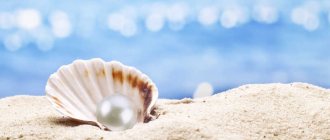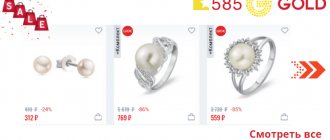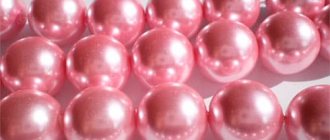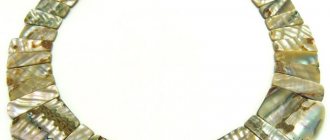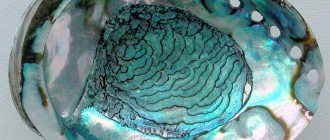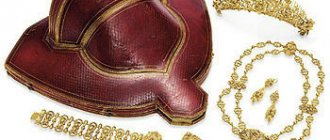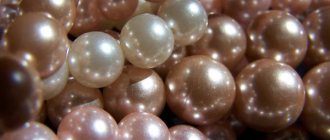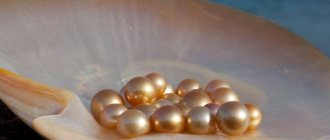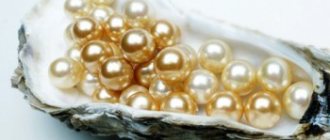The Darwin Museum opened an exhibition “Pearls and Mother of Pearl”, dedicated to these natural materials and the history of their use in the decorative and applied arts of different countries. The exhibits range from mollusk shells to jewelry, from antique household items to contemporary art, from several museums, private collectors, and workshops. Olga Strelkova, the author of the exhibition, told mos.ru about the most interesting of them.
Attention: a QR code is required to visit the exhibition. Please remember to wear personal protective equipment and social distance in the museum.
Abalone shells
Translated from German, the word “nacre” means “mother of pearls” . Grains of sand or pebbles that fall into the shell of a mollusk are covered with layers of mother-of-pearl, resulting in a pearl. The mother-of-pearl layer is not found in all mollusks. Its shade depends on many factors, including the composition of the water and trace elements that penetrate the sink. For example, the appearance of pink pearls is due to the admixture of manganese, and green pearls are due to the presence of chromium.
The shells of mollusks of the genus Haliotis have a mother-of-pearl layer of fantastic shades. They are also called abalone (or abalone) due to their appearance. Pearls very rarely appear in them, and if they do appear, they are of irregular shape. Because of their bizarre outlines, such pearls are called “baroque” .
By the way, it was this mollusk that inspired Mikhail Vrubel to create the painting “Pearl”: the artist depicted pearl girls in the shell of abalone. He once received such a sink as a gift from Maximilian Voloshin and was captivated by its shape and iridescence.
Products decorated with abalone are found among different peoples, since these mollusks live at shallow depths in many seas. The Maori natives of New Zealand called them "paua" and highly valued them.
The exhibition “Pearls and Mother of Pearl” presents replicas of traditional New Zealand products, which were created by contemporary artist Ilya Belyakov based on museum samples. The Maori decorated ceramic masks with abalone, which were placed on the bow of the canoe to protect against evil spirits, as well as wooden teko-teko figurines , intended to protect the house and yard. It was believed that the mother-of-pearl eyes of the figurines, reflecting light, would protect the owners of the house while they slept.
Cowrie bracelet
The shells of these mollusks are so beautiful that they were once used on the islands of Oceania instead of money. If you have such a shell, try making a fashion accessory.
Accessories are sold in textile departments of markets.
You will need:
- Cowries;
- Cord;
- "Floss";
- Beads or large beads;
- End clamps with loops;
- Clasp;
- Split ring;
- Scissors;
- Pliers.
Operating procedure:
- We make holes in the shell at the ends.
- We measure 2 dm of silk cord.
- We pass it through the hole half the length and tie a knot on the outside of the shell.
- We do the same with the second hole.
- We put together several threads of floss of a suitable color, throw them over the cord next to the cowrie, and tie them with a small piece of cord. It turns out to be a brush. For example, in our photo the purple floss tassel is contrasted by the white cowrie, gold beads and blue cord.
- We collect beads or beads to the right and left of the shell.
- We bend the ends of the cord in half and insert them into the clamps. Using pliers we compress the end switches and cut off the excess.
- We attach a ring to one end, and a carabiner to the other. The bracelet is ready!
From snuff boxes to guitars
A special type of mother-of-pearl inlay - in lacquer miniature - appeared in the 8th century in China, and then spread to Korea, Vietnam and Japan. The craftsmen selected shells of different shades to match the theme of the future miniature. The required pieces of mother-of-pearl were inserted into the recesses of the design and glued. The product was sanded by hand and then covered with several layers of varnish. To this day, there are entire villages in Vietnam and China that practice mother-of-pearl inlay.
The Oriental Museum provided for the exhibition several objects created in Vietnam at the end of the 19th and beginning of the 20th centuries. Among them are an album, vases, a table and a panel depicting the seasons.
Ivory, bidri and Vishnu avatar. Five Indian exhibits of the Museum of the East Morinhur and the mask of the mystery. Five exhibits from the Mongolian collection of the Museum of the EastDaruulga, Guu and White Tara. We study the Buryat collection of the Museum of the East Choydish, munisak and lyagan. Treasures of the Uzbek collection of the Oriental Museum
In Europe, mother-of-pearl began to be used in the 17th century; it was used to decorate fans, cases, snuff boxes, and caskets. Craftsmen often used whole mollusk shells. At the exhibition you can see, for example, a case for a pocket watch made from a single shell of a sea pearl oyster. It was made in France in the first half of the 19th century. The mother-of-pearl pearl oyster is framed in bronze, and the inside of the case is lined with velvet.
Sometimes craftsmen carved images of Christian saints on pearl mussels. Such icons became widespread in Palestine at the end of the 19th and beginning of the 20th centuries. They were brought to Russia by pilgrims who went to Palestine on pilgrimage.
One of the most interesting exhibits is a six-string guitar from the Ostankino estate museum. It was made in 1822 in St. Petersburg by the Polish master Frantisek Mackiewicz, who specialized in expensive guitars. The upper soundboard of the instrument and the resonator rosette are decorated with mother-of-pearl. You can also see a mother-of-pearl carved plate with the owner's monogram and a coat of arms with an image of an eagle.
Children's crafts from shells
Children usually make appliqués or panels out of shells.
- Fish applique - Scallop shells representing fish are glued onto hard cardboard using glue.
- Turtle Applique – A large scallop can be used to make a sea turtle. The paws and head can be made from suitable shaped green fragments of bottles rounded by the sea, or flat sea pebbles.
In addition, you can make many more beautiful things from shells. Your imagination can be limitless here.
Mother of pearl in fans
Mother of pearl began to be used in decorating fans from the beginning of the 18th century. For a long time they used only the engraving technique; later they began to experiment with carving. Craftsmen cut fan plates from the shell and passed them on to a fan maker, who polished, engraved and turned the tips to perfection. The plates were then connected using a metal pin. The last stage of creating a fan - connecting the fan screen to the frame plates - is considered the most difficult.
Over time, the shape and decor of fans changed, following fashion trends. The fashion for the shade of the material itself also changed. For example, masters of the 18th century preferred white mother-of-pearl, decorating it with carvings, gilding and silvering. And in the 19th century, they began to use a variety of shades - from soft pink to deep blue and green.
The exhibition presents fans from the collection of the Ostankino museum-estate, created in France from the 18th to the beginning of the 20th century. They demonstrate different techniques for processing mother-of-pearl. For example, on the plates of the fan “The Delights of Country Life” (1770s) you can see relief carvings with silver and gold foil. And this wedding fan, created in the 1860s, depicts a scene of the bride getting ready. She is helped by her friends and cupids, and there are jewelry boxes around her. Mother-of-pearl plates develop the theme of decoration: they are completely covered with the finest carvings in the form of a gilded trellis mesh, often used in the Baroque and Rococo styles.
Romantic candles
Sea shells are almost ready-made candlesticks that can be used to create a romantic mood.
Materials for work:
- Large shells;
- Candles in foil (any kind is possible);
- PVA glue.
Step-by-step instruction:
- Remove the candle from the foil and remove the wick by pulling the base at the bottom of the candle. Return the candles to the foil.
- Glue the wick in the center of the shell.
- Melt the paraffin on the stove until liquid and use pliers or tweezers to pour the contents into the shell.
If you are afraid that the paraffin will harden unevenly, first install the shell firmly. After the paraffin has hardened, the candle is ready.
Black Pearl
By the beginning of the twentieth century, natural reserves of sea and river pearls were depleted. This is not surprising: to find one large pearl, up to 10 thousand shells were caught and opened. As a result, many species of shellfish were on the verge of extinction, and fishing was sharply reduced.
Today, there are dozens of varieties of cultured pearls. Black is considered one of the most beautiful. Its name is quite arbitrary: shades vary from gray to iridescent blue. The latter are the most valuable. The exhibition features a magnificent black pearl of irregular baroque shape from a private collection.
Cultivation of artificial freshwater pearls began in China back in the 13th century: a ball of clay, copper or tin was placed in a shell, which was gradually covered with mother-of-pearl. But mass pearl cultivation began in Japan. Kokichi Mikimoto , the son of a noodle shop owner, became the founder of a huge industry: today almost all pearls in the world are grown using his method. Mikimoto created the first plantation in 1888; five years later he managed to grow a semicircular pearl, and a round one only after 15 years.
Drilling holes
To make many crafts, holes must be made in shells.
- For this, drills from 0.8 to 2 mm in diameter installed in a screwdriver are suitable.
- If you don’t have such a tool, you can use a regular needle or a thin nail.
- The steel needle is harder than the shell, so it can also drill a hole.
- To do this, you need to make an initial puncture and carefully drill it out in a circular motion.
- Sometimes shells crack due to this procedure.
- We must not forget that to drill through a thicker shell, a thicker drill is selected.
- Accordingly, the thread and accessories must also be suitable.
- It is better to secure the shell with adhesive tape and drill through it.
Japanese divers
The profession of ama (as divers for algae, shellfish and mainly pearls were called in Japan) dates back more than three thousand years. It was mainly women who did this: they could hold their breath longer than men and froze less in the water due to a thicker layer of subcutaneous fat. The divers used a knife, a light net and a wooden barrel with a glass bottom. Through it they looked for mollusks, and between dives they used it as a float for relaxation. This hard, but very profitable work often became the subject of engravings by Japanese artists. At the exhibition you can see a triptych of engravings from the mid-19th century , provided by the Oriental Museum, depicting divers.
Laughing Hotei and bowl in wabi style. Treasures of the Japanese collection of the Oriental Museum
The series “Ama, pearl divers” by contemporary Russian artist Alexei Iorsh . He created four graphic works specifically for the exhibition “Pearls and Mother of Pearl”. The drawings refer, on the one hand, to traditional Japanese painting, and on the other, to the manga of the Japanese artist and writer Sanpei Shirato “The Legend of Kamui”.
Four works describe the process of pearl fishing: first, a diver, flexible and plastic, like the fish around her, plunges into the water, then (with the prey) she pushes off from the bottom and swims to the surface. The third shows how heavy her burden is, and the fourth shows how great the price of this work is: it was necessary to fish out hundreds of shells to find only three treasured pearls.
